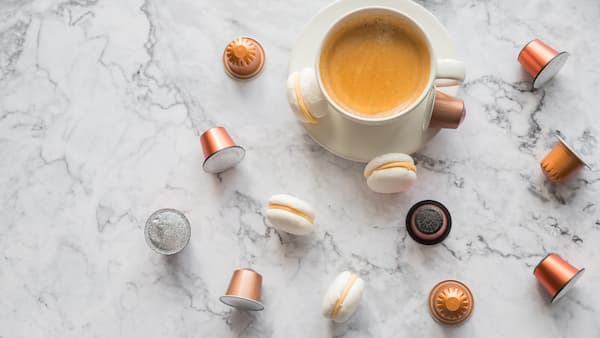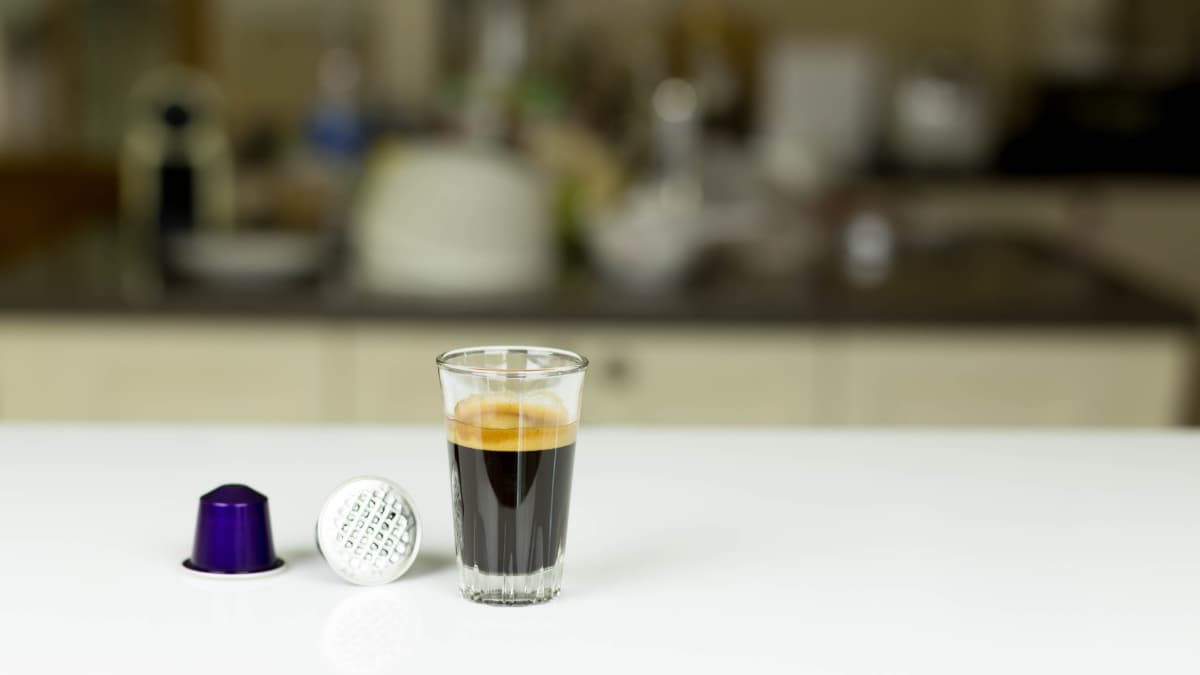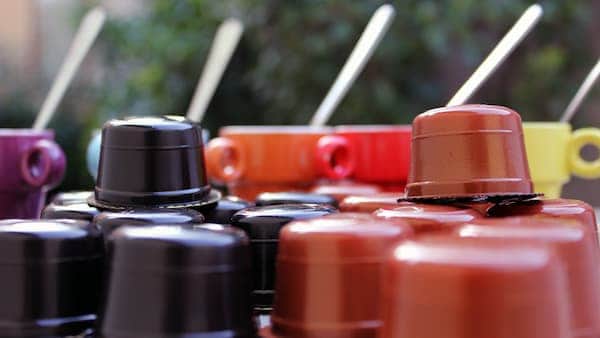How Does A Keurig Work – Understanding K-Cup Brewers
When you want a quick cup of coffee at home, what comes to mind? No doubt, K-Cups.
They’re easy to use, quick, and require no coffee-making skills.
Do you get the best possible cup of coffee by using a Keurig? Let’s find out by examining how a Keurig coffee brewer works and if you should use one.

What is a K-Cup?
A K-Cup is one of the most convenient and effortless ways to brew coffee – the secret to its success.
K-Cups can be purchased almost anywhere in the United States – online, in supermarkets, at convenience stores. Even some specialty coffee shops sell them.
Keurig cups are ready-to-use individual servings of coffee that come in boxes of 12, 24, 72 (or more) cups. How do K-Cups work?
To create the cups, ground coffee is placed in a paper filter, packed away in a small plastic cup or pod, and sealed with a layer of aluminum foil.
When you pop that cup into the Keurig coffee maker, a needle punches a hole in the foil on the top. Another needle creates a similar hole in the bottom of the pod – after all, the brew needs to escape somewhere!
Then the Keurig coffee brewer forces pressurized water through the pod, lets the coffee brew, and directs the freshly brewed coffee down into your cup.
John Sylvan, the creator of the Keurig brewing machine, set out to design the easiest way to brew coffee. He succeeded.
Coffee brewing could not be simpler.
Related Read: K-Cup Coffee Review
How K-Cups Work
As we mentioned, K-Cups come ready to use, with the ground coffee already in them. You don’t have to measure out coffee or water. All you have to do is pop the cup into the coffee machine, press a button, and wait a minute while the brewer serves you your brew.
You can purchase your K-Cups and coffee maker directly from Keurig, or you can see if your favorite brand of coffee makes K-Cups. Since Keurig works with about 200 types, you’ll probably be able to find coffee flavors you like.
The advantage of these foil-topped plastic pods is that they keep the elements out. The coffee is protected from damaging elements like sunlight, humidity, and oxygen, which degrade coffee and give it a flat taste.
The disadvantage of those individual Keurig pods is the environmental waste, but we’ll discuss that later.
You can also purchase reusable Keurig cups to avoid that waste. Using reusable cups that you fill gives you the freedom to choose which coffee you want to drink.
Keep in mind that the reusable cups might not create the same pressure inside the pod as the original ones. Less pressure will affect the taste and body of the brewed coffee.
Also, some Keurig coffee makers are designed to make using reusable cups difficult, if not impossible.

The Keurig Brewer
All Keurig coffee brewers work with the same basic technology, although brewers vary widely in size, shape, design, and bells and whistles.
How does a Keurig work? There are just 5 steps to use it:
1. Pop open the lid of the compartment.
2. Drop the pod into the slot.
3. Close the lid.
4. Place a coffee cup or mug on the drink plate.
5. Push the brew button.
It is that easy.
Let’s go into some details.
Before starting the brewing process, make sure you have enough clean water in the water reservoir. Press the power button beforehand so that the machine starts to heat up the water. Many models have a light that lets you know when it’s heating.
When you’re ready to start brewing, lift the handle of the brewer and pop in the K-Cup. Don’t remove the foil top on the cup. Pressure is necessary to brew coffee in such a short time, and the foil aids in maintaining pressure.
Push the handle down to close the lid. After you close the lid, select your cup size. If you have a Keurig coffee maker with a menu button, such as the Keurig 2.0, you might be able to choose how strong you want your brew and if you want hot or iced coffee.
Don’t lift the lid while the coffee is brewing, since you could you injured by steam. Once the coffee is brewed, simply lift the lid and remove the used K-Cup. Keep in mind it will be very hot.
When necessary, simply wipe your Keurig coffee brewer with a damp cloth to clean. The drip tray is removable so you can easily clean it.

Why Keurig Coffee Is Quick To Brew
So let’s get to the heart of the matter – why do people love Keurig coffee?
Those Keurig cups are incredibly simple and fast to use.
No mess – you won’t get coffee grounds all over the counter as you’re trying to fill a filter. With a K-Cup, it’s done for you.
No need to weigh or measure coffee – this is a big plus when you can barely open your eyes in the morning before your first cup of joe. You might not want to weigh out your coffee, and with a K-Cup you don’t need to weigh or measure anything.
Brews in a minute or less – since the Keurig brewing system uses pressurized water in a small brewing cup with a foil seal, the brewing is done fast.
No messy cleanup – just toss the cup in the trash and you’re done.
K-Cups VS Drip Coffee
Keurig K-Cups are an incredibly uncomplicated way to brew a single cup of coffee. However, drip coffee is still popular in the United States.
It takes a few more minutes to brew in a drip coffee machine, and cleanup is a bit more complex.
But drip coffee can still be the best choice when brewing for larger groups, since most Keurig coffee makers brew individual cups. Even the Keurig 2.0 coffee maker only brews up to 4 cups.
A drip coffee maker is also a better choice when you want to protect the environment or use coffee from a company that doesn’t make Keurig cups.
And drip coffee is certainly easier on the wallet.
PROS (+)
- Drip coffee can be brewed in much larger batches
- Less expensive than Keurig cups
- Less environmental waste
- You have more options
- Some drip makers have sophisticated brewing techniques and produce exceptional coffee
CONS (-)
- Coffee has to be measured out for each batch
- Cleanup is more complex – you have to wash the coffee carafe, filter basket, and other utensils
K-Cups VS Coffee Pods
A coffee pod is different from a K-Cup in a number of ways.
A coffee pod is coffee grounds that are sealed inside a pouch made of filter paper. Coffee pods are rather flat and round, as opposed to the cup shape of Keurig cups.
You can only brew a pod in a special pod brewer – they’re not compatible with a Keurig coffee maker, and a K-Cup can’t be used in a pod brewer.
PROS (+)
- Less expensive than Keurig cups
- Compostable
- Richer tastes in the cup
CONS (-)
- Less variety in types and regions
- Not as available on the market
What’s Bad About a Keurig?
With all these positives, you might ask yourself if there are any disadvantages to using a Keurig coffee maker.
The answer to your question is, yes. And they are rather big drawbacks. Let’s hit the most important ones.
What Quality Coffee Does A Keurig Cup Use?
The answer to that varies widely. Some Keurig cups will use basic coffees. Others will boast single origin, organic, or Fair Trade. Some will even tell you the variety.
Will you get a full range of choices? As I’m writing this article, I’m drinking an organic coffee from Tolima, Colombia. The variety is Caturra, it was grown by the Nieto family on their farm, Los Aguacates. They used a washed process, and it was roasted 3 days ago.
Can you get that in a K-Cup? I haven’t seen it yet.
What Quality Coffee Does A K-Cup Brew?
Many people love the taste of Keurig coffee. It’s better than they could brew at home, and might be much better than what they get at their local shop.
So why do coffee snobs say that Keurig cups don’t brew a real cup of coffee?
One complaint is that it can taste watery and diluted, no matter how you adjust the settings. And for people who enjoy the precise flavor extraction you can get from brewing a pour over coffee, a Keurig is just not going to cut it.
Is coffee in a K-Cup fresh?
There are two ways to look at freshness.
Freshness can be an actual fresh product. Think of going to your garden in the summer and picking a vine-ripened tomato. That’s fresh.
On the other hand, a can of tomatoes can be considered fresh in the sense that it’s not damaged. Canning the tomatoes keeps them edible even though they were canned years ago.
Is your Keurig coffee fresh? Yes, in the second sense. Coffee grounds in a K-Cup is protected from the elements, so the coffee is not stale.
Is it fresh in the vine-ripened tomato sense? No, because the coffee was packaged many months ago.
Is that freshness important to you? Only you can decide that.
How much do K-Cups cost?
Let’s do the numbers.
K-Cup pods cost a bit less than $1 for a pod, which makes a cup of coffee.
Is that expensive?
If you compare it to a cup of coffee at a coffee shop, that’s incredibly cheap. If you swap out getting coffee at a shop for a Keurig brewer at home, you’d save yourself a lot of money.
You even save yourself time – it’s much faster to brew a Keurig at home than to drive or walk to your favorite coffee shop.
And you may perhaps get the same quality of coffee, depending on how good your local coffee shop is.
However, if you compare that to buying a bag of coffee and brewing it at home in, say, a French Press that requires no filters, how do Keurig cups hold up?
Most Keurig cups have 9-12 grams (0.3-0.4 ounces) of coffee in each pod. That comes to about $30 for a pound.
You can purchase a mighty good specialty coffee for that price, a coffee that’s going to wow your socks off every time you brew it.
Prices for Keurig cups can start at about $15 for a 24-count box, which is easy to drink through in a few days (depending on your coffee habits).
Are K-Cups bad for the environment?
At 33 million households using Keurig home brewers just in the United States, discarded plastic coffee cups are a huge environmental concern.
What is a K-Cup made of?
- Coffee, of course
- Paper filters
- Plastic
- Aluminum foil layer
Are the materials recyclable?
Older Keurig cups were not recyclable. By 2020, all K-Cups have recyclable elements. Whether or not people actually recycle them is another story.
After all, if you toss the cups in the trash, they won’t be recycled.
And even with the newer Keurig cups, whether or not you can recycle them depends on the regulations in the area you live in. Check with the authorities in your area to see if you can recycle them.
If you can recycle them, you need to separate the components beforehand. You need to peel off the foil and throw out the ground coffee, paper filter layer, and foil lid. Put the plastic cup in the recycling bin.
FYI, you may need a box cutter or similar sharp instrument to separate these little pieces.
Why shouldn’t you use a Keurig?
I’m a coffee professor, which provokes a range of emotions in people as they discuss their coffee-brewing habits. Regarding the use of a Keurig brewing system, people often confess to me (with shame in their voice) “I use K-Cups at home.”
Should they feel bad?
NO.
And yes.
No one should feel bad about brewing coffee. Coffee is a beautiful thing.
Many people have little time or energy in the morning to be fiddling with a freshly brewed pour-over. And they have the extra cash to spend on convenient pods. Keurig brewing systems work for them, and that’s fine.
However, if you’re searching for a wallet-friendly cup of coffee, you won’t find it in Keurig brewers.
And if you’re a coffee lover who wants a spectacular fresh roasted coffee, you may want to purchase a brewing method and go through the extra steps of grinding your coffee and preparing it by hand. The boost in taste and satisfaction is worth it.

